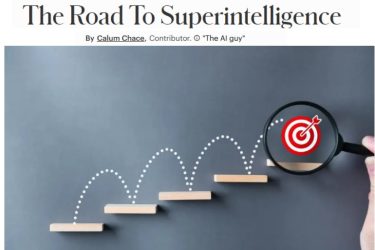 Here’s a brief history of the human race, plus a glimpse into our near future.
Here’s a brief history of the human race, plus a glimpse into our near future.
A few geological seconds ago, our ancestors discovered that cooking meat made it safer, more nutritious, and longer-lasting. Cooked food is an efficient fuel, and it enabled the human brain to grow.
Brains are expensive in terms of energy: ours use 25% of all the energy we consume. If you’re going to have a bigger brain, you need a more efficient source of energy. The human brain is not the biggest in the animal kingdom, but it is large proportionate to our size and weight.
Our bigger brains give us many competitive advantages in the Darwinian struggle for survival, and many of these advantages stem from our ability to communicate and co-operate. Co-operation enables us to hunt together, to band together for self-defence, and to collaborate on tool development.
It is often said that no species is more savage and more violent than humans. This is no more true than the claim that Americans are more violent than other nationalities because their murder rate is higher than other developed countries’. Like Americans, humans kill more than other species simply because we have more and better weapons.
Humans live cheek by jowl in cities containing millions. No other carnivorous species can assemble more than a few dozen of its members in a limited space without killing each other in rivalry for food, sex, or social dominance. The reason for this is that they lack our sophisticated ways to communicate and collaborate. Our bigger brains allow us to talk to each other and communicate by writing. We establish laws and cultural norms which govern the way we interact. Primates spend hours grooming each other to reassure each other that they will not sink their teeth and nails into each other, but this is very inefficient, and they cannot readily add new members to their tribe. Humans can walk past strangers in crowded streets without a second thought.
Of course, we often use our fabulous communication abilities for trivial purposes. It is often said that every new medium (books, cinema, TV, the internet) succeeds only when someone figures out how to use it for porn. I don’t know whether that is true, but it is certainly true that a lot of the traffic on Tim Berners-Lee’s fabulous invention is trivial stuff: a friend of mine calls it the “intercat”. But even these apparently trivial uses are important. Gossip and shared jokes are the glue that holds the human tribe together.
But what, I hear you ask, has this to do with artificial intelligence? Isn’t AI the subject of this blog rather than social paleontology? Very well, let me get right to that.
It might seem odd that the instrument which brought artificial intelligence to consumers is the smartphone. Who would have guessed, thirty years ago, that we would all carry around computing power which would have cost billions of dollars in the 1970s – inside telephones! Is that just a fluke? An unintended consequence of Steve Job’s quirky genius?
No, it is due to our intense need to connect. The reason there are seven billion of us busy re-shaping the planet while our close cousins the chimpanzees (who share 98.5% of our DNA) live in scattered communities, close to extinction, is that we can communicate, and we love to do it.
(The tragedy of the chimps, by the way, is not only that they do not know what has hit them. They do not even know that it has hit them. A salutary lesson for us to bear in mind as we beaver way developing artificial minds smarter than ourselves.)
And so, with considerable regret, I have decided it is time to short Apple. Steve Jobs may not have been the nicest human being, but he was a genius, and his company has produced a stream of products which I have loved. Not just liked, but loved, which is not something that many companies achieve.
Most of all, Apple put artificial intelligence into our hands, putting all the wonders of the intercat at our fingertips throughout the day.
But now the next step in the evolution of connectivity is upon us. Google Glass will mean the always-on internet, with connection to each other and to all of human knowledge, is available in a head-up display. It might take a while for Glass to become both smoothly functioning and affordable. There might be some resistance and some push-back, with wearers being derided as Glassholes. But I fully expect that within two years, you will see Google Glasses on the faces of half the people walking the streets in central London and New York. And I wouldn’t be surprised if it happens faster than that.
Google’s marketing of Glass has been masterful. They have charged their beta testers a phenomenal price ($1,500) for helping them develop a half-finished product, and those guinea pigs have relished the status it has given them in their tech-obsessed communities. Google is holding back the consumer launch until the product is fully ready, and waiting for much of the cultural resistance to express itself and evaporate before it is actually available.
Maybe Apple has a competitive product up its sleeve. All I’ve heard is that they are working on a smart watch. But why would anyone think that a tiny screen on your wrist can match a head-up display which can occupy as much of your field of view as you want, and is always available right before your eyes? Google Glass takes the internet out of your pocket and puts it in your face, which means it should eat Apple’s iPhone lunch (although not the iPad, the Macs and so on.)
Now, how do you buy a put option?

PS. Other smart glasses are of course available. Maybe Apple will buy one?


